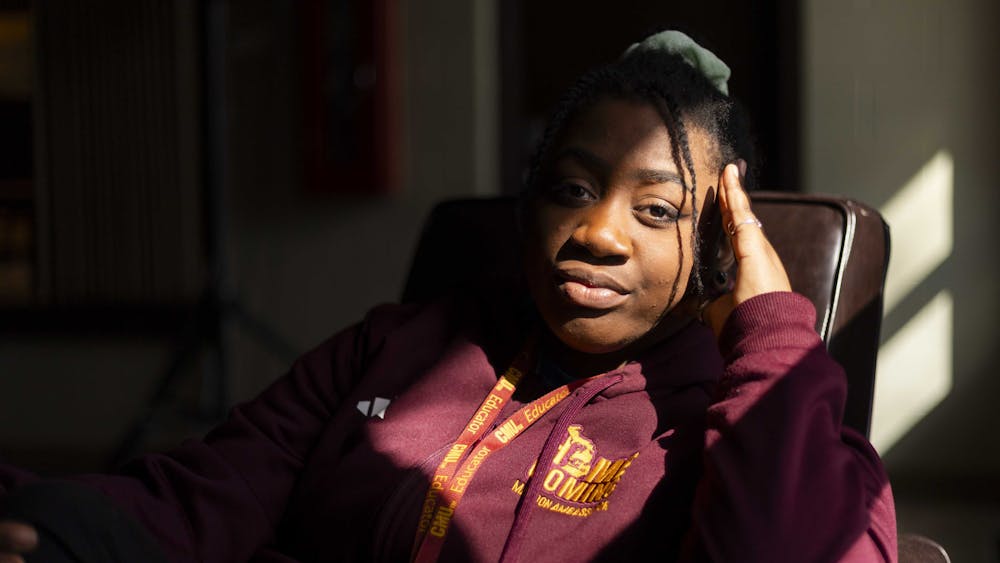Master plan forums vet ideas for new signage, overhauls building designs
Central Michigan University officials are planning to make campus easier to navigate with the introduction of new campus signage, as well as making major changes to the design plans for Warriner Mall and the to-be-constructed Biosciences Building.
Design proposals for the signage and the building changes were presented during four open forums discussing changes to the campus master plan.
Global contractor AECOM helped CMU officials create the master plan. Jonathan Mugmon, AECOM’s wayfinding director, said the proposed signage upgrades are crucial to the beautification of CMU.
“(We’re making) plans for where walking and bicycle paths will go so people can feel comfortable walking in this environment,” Mugmon said. “They’ll know that it’s safe, that it’s a nice environment. This whole project will encourage walkability when it’s finished.”
The campus identity project will cost $310,000, including five weeks of charrettes, work done by AECOM throughout the process and deliverables sent after the final March charrette.
The directional sign posts will be more detailed and easier for pedestrians to read, Mugmon said. Proposals regarding pedestrian traffic are a main focus of the plan, placing directional signs along popular walking spots on campus and near popular local destinations.
Designs for the signage will include three distinct graphic elements. The first will detail the specific area where the sign is located, including street names, surrounding landmarks and paths to those locations. The second element proposed is the creation of 3-D rendered maps of that particular area of campus. Lastly, a map of the entire campus will be incorporated in the final designs.
Pedestrian signage will also include walking times to various nearby locations, with arrows designating direction.
“When students see these, they’ll go ‘maybe I don’t have to use my car. It’s only a five-minute walk,’” Mugmon said.
Street signs on campus will also receive a major revamp. At present, campus street signage is located in the middle, toward the left, or on the back of campus stop signs.
The new renovations will place every street sign on the right side of the road where drivers can easily see them. The signs will also be simplified so they are easier to read.
Proposed changes to parking signage will also be simplified to streamline the campus parking system. There are 14 different color and letter classifications for the myriad parking lots on campus.
The new system will help simplify who can park in any lot by reducing the classifications to five colors and letters, labeling parking lots for visitors, faculty, staff, meter users and residential parkers.
Designs for the wayfinding signage have not been finalized. Sherry Knight, associate vice president of communications at CMU, said discussion of weaving the project into the 10-year capital plan will begin in March and will be funded by private donations.
Warriner Mall and Biosciences changes
Both the Biosciences Building and the Warriner Mall area, located outside Warriner Hall, were selected as test models for the forums, and will serve as templates for the entire master plan.
The changes to these areas could also create space for a future bike trail, and align more ideally with the master plan.
In both cases, the proposed changes were significant.
For the Biosciences Building, which is scheduled to start construction this summer and finish in December 2016, the most significant proposal is to lower the building four feet into the ground and shift the building 20 feet to the east.
Steve Lawrence, vice president of Facilities Management, said an estimated cost of all the changes would not be finalized until AECOM completed its work.
Shifting the Biosciences Building 20 feet to the east would force the university to eliminate Calumet Court. CMU would also have to create another road in the process.
Lawrence said CMU is sampling soil at the proposed location to make sure the ground can support such a heavy structure.
“The building is so extremely heavy,” he said. “The soil can be very diverse. We want to make darn sure what we have there is suitable.”
Other changes, including the creation of plaza spaces in the entrance ways, will bring the building up to date with Mount Pleasant fire and emergency requirements.
The Warriner Mall area will be given a new landscape outlay. Trees planted in front of Warriner Hall could be removed and relocated to the side of the park area, giving passersby a clear view of the building. New grass will also be planted in the open area.
Sechler said the changes are necessary and could be inexpensive.
“I don’t want to undersell this and say it can be fixed on a dime,” Sechler said, “but we’re talking about moving trees, planting new grass and constructing new banners and entry ways.”
Tony Voisin, assistant vice president for Student Affairs, was enthusiastic while looking at the drawings for the proposed changes.
“For me, having been here for 30 years, I was a student, (these changes represent) who we’ve always wanted to be,” he said. “That visual impact. It’s so beautiful. It’s so powerful, for visiting students, alumni, it opens up what we always thought was there.”
Editor’s note: Central Michigan Life’s coverage of the master planning process contained several errors. This is a corrected version of two stories.




